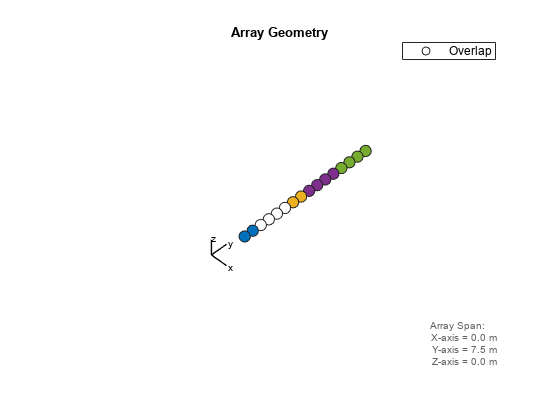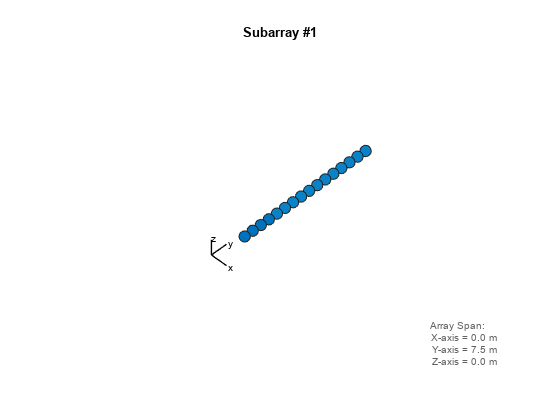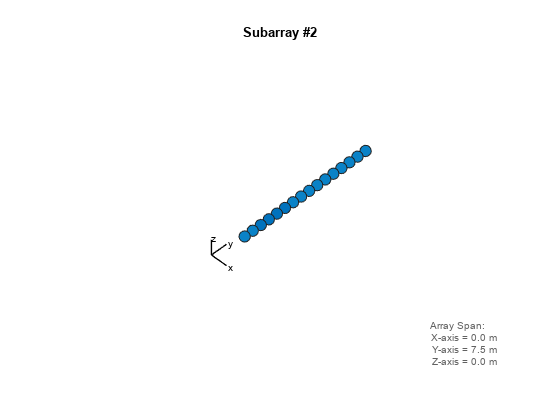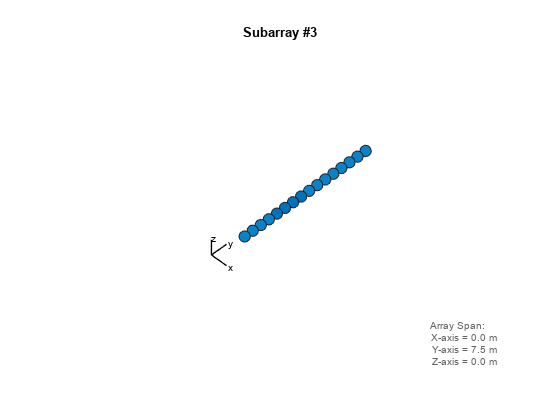viewArray
View array geometry
Description
viewArray(
plots the geometry of the array, with additional options specified
by one or more array,Name,Value)Name,Value pair
arguments.
hndl = viewArray(___)
Examples
Display the geometry of a uniform linear array having overlapped subarrays.
Create a 16-element ULA that has five 4-element subarrays. Some elements occur in more than one subarray.
h = phased.ULA(16); ha = phased.PartitionedArray('Array',h,... 'SubarraySelection',... [1 1 1 1 0 0 0 0 0 0 0 0 0 0 0 0;... 0 0 1 1 1 1 0 0 0 0 0 0 0 0 0 0;... 0 0 0 0 1 1 1 1 0 0 0 0 0 0 0 0;... 0 0 0 0 0 0 0 0 1 1 1 1 0 0 0 0;... 0 0 0 0 0 0 0 0 0 0 0 0 1 1 1 1]);
Display the geometry of the array, highlighting all subarrays.
viewArray(ha);

Each color other than white represents a different subarray. White represents elements that occur in multiple subarrays.
Examine the overlapped subarrays by creating separate figures that highlight the first, second, and third subarrays. In each figure, dark blue represents the highlighted elements.
for idx = 1:3 figure; viewArray(ha,'ShowSubarray',idx,... 'Title',['Subarray #' num2str(idx)]); end



Input Arguments
Phased array, specified as a System object.
Name-Value Arguments
Specify optional pairs of arguments as
Name1=Value1,...,NameN=ValueN, where Name is
the argument name and Value is the corresponding value.
Name-value arguments must appear after other arguments, but the order of the
pairs does not matter.
Before R2021a, use commas to separate each name and value, and enclose
Name in quotes.
Example: ShowNormals = true,ShowIndex = 'All',ShowTaper =
true
Handle to the axes along which the array geometry is displayed.
Option to show normal directions, specified as
the comma-separated pair consisting of
'ShowNormals' and a logical
value.
true— show the normal directions of all elements in the arrayfalse— plot the elements without showing normal directions
Example: false
Data Types: logical
Logical flag specifying whether to show the local coordinate axes.
Data Types: logical
Logical flag specifying whether to show the annotations in the UI panel of the figure. Annotation shows aperture size and element spacing based on array axis of array.
Data Types: logical
Orientation of the array, specified as a 3-by-1 column vector containing the rotation angles with respect to the x-, y-, and z-axes of the local coordinate system, respectively. The default value is [0;0;0].
Data Types: double
Option to show taper magnitude, specified as
the comma-separated pair consisting of
'ShowTaper' and a logical value.
true— change the element color brightness in proportion to the element taper magnitudefalse— plot all elements using the same color
Example: true
Data Types: logical
Element indices to show in the figure,
specified as the comma-separated pair consisting
of 'ShowIndex' and a vector of
positive integers. Each number in the vector must
be an integer between 1 and the number of
elements. To show all of indices of the array,
specify 'All'. To suppress all
indices, specify 'None'.
Example: [1,2,3]
Data Types: double
Vector specifying the indices of subarrays to
highlight in the figure. Each number in the vector
must be an integer between 1 and the number of
subarrays. You can also specify the value
'All' to highlight all
subarrays of the array or
'None' to suppress the subarray
highlighting. The highlighting uses different
colors for different subarrays, and white for
elements that occur in multiple subarrays.
Data Types: double
Plot title, specified as a character vector.
Example: 'My array
plot'
Data Types: char | string
Output Arguments
Handle of array elements plot in the figure window, returned as a scalar.
Version History
Introduced in R2012a
MATLAB Command
You clicked a link that corresponds to this MATLAB command:
Run the command by entering it in the MATLAB Command Window. Web browsers do not support MATLAB commands.
Select a Web Site
Choose a web site to get translated content where available and see local events and offers. Based on your location, we recommend that you select: .
You can also select a web site from the following list
How to Get Best Site Performance
Select the China site (in Chinese or English) for best site performance. Other MathWorks country sites are not optimized for visits from your location.
Americas
- América Latina (Español)
- Canada (English)
- United States (English)
Europe
- Belgium (English)
- Denmark (English)
- Deutschland (Deutsch)
- España (Español)
- Finland (English)
- France (Français)
- Ireland (English)
- Italia (Italiano)
- Luxembourg (English)
- Netherlands (English)
- Norway (English)
- Österreich (Deutsch)
- Portugal (English)
- Sweden (English)
- Switzerland
- United Kingdom (English)